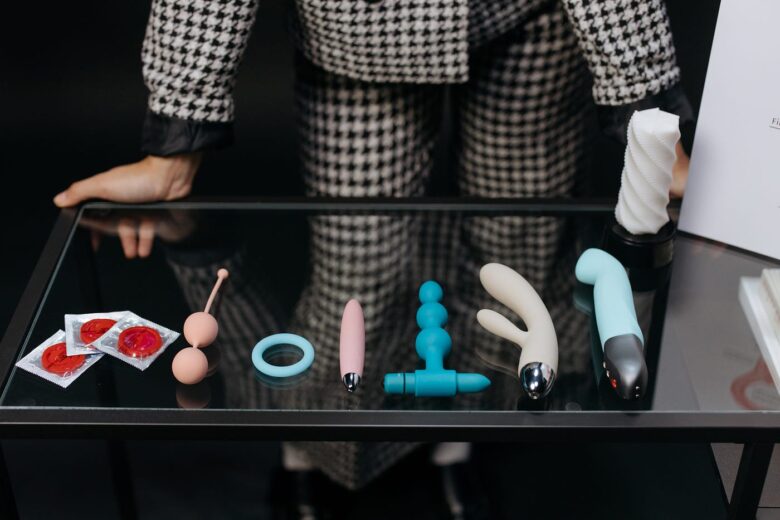Fear is a natural human experience, and when it comes to the intimate realm of sex, anxiety, and insecurity can sometimes take center stage. While societal stigmas and personal concerns can contribute to these fears, it’s crucial to remember that sexual exploration and pleasure should not be overshadowed by apprehension.
In this article, we’ll address some of the most common misconceptions and fears surrounding sex toys and shed light on the truth behind them. By dispelling these myths with accurate information and open communication, we can pave the way for a more liberated and satisfying sexual experience.
1. Toys Will Replace Intimacy with a Partner

In the realm of human sexuality, our sense of self-worth often intertwines with our perception of sexual attractiveness. The affirmation of being desired can be incredibly validating and fulfilling. However, introducing sex toys into a relationship can sometimes trigger concerns that go beyond the mere physical act. The fear that a sex toy might replace the intimate connection with a partner can evoke a sense of competition, leading to subconscious anxiety.
When navigating the uncharted territory of incorporating sex toys into a relationship, open and honest communication becomes paramount. Instead of assuming that your partner understands your motivations, take the initiative to discuss why you’re interested in exploring this avenue and what you hope to achieve through it. While it may be evident that the purpose of these toys is to enhance pleasure, the intricate emotions tied to intimacy require direct dialogue. Rather than settling for vague phrases like “Do you want a vibrator?” or “Can I buy you a dildo?”, delve deeper into your desires.
Sharing your genuine enthusiasm and intentions with a partner you trust goes beyond the surface level of conversation. By doing so, you create an environment of understanding, paving the way for effective communication that dispels misunderstandings and alleviates insecurities. Your partner will appreciate your candor, and this open approach can even lead to joint exploration of specific types of toys that align with both of your preferences. Ultimately, the pathway to embracing sex toys within a relationship is illuminated by authenticity, mutual respect, and the thrill of discovering new avenues of pleasure together.(Click here to pick your favorite toy)
2. Larger Toys Will Cause Discomfort and Diminish Pleasure

Source: theguardian.com
The misconception that larger sex toys lead to permanent changes in satisfaction stems from anxieties about self-worth and comparisons to penis size. This raises the question: Can using larger toys compromise the pleasure of “standard” experiences?
Let’s delve into the scientific reality. The vagina’s remarkable elasticity allows it to expand during arousal and revert post-activity. In a resting state, the average vaginal length is around 2.5 inches, but arousal can extend this to 4.5 to 7 inches or more. Notably, this flexibility exists without toy usage. Just as penis size and height vary, so does vaginal width.
While some prefer larger sizes, most individuals find accommodating sizable toys doesn’t diminish pleasure with partners of average size.
A comprehensive study involving 52,000 participants revealed that 84% of women were content with their partner’s penis size, but only 55% of men felt good about their own size. A mere 6% of women considered their partner’s size below average. Clearly, size anxiety looms large.
The same applies to anal play. The adaptable rectum can be trained through gradual progression, much like an exercise routine. If discontinued, the stretching ability wanes and requires reconditioning.
For larger anal toys, proceed slowly, use quality lubrication, and stop if discomfort arises.
Fears of oversized toys altering pleasure lack foundation. The body naturally adapts and retains its state. With accurate information, care, and communication, you can free yourself from misconceptions and embrace diverse pleasures.
3. Vibrators Will Desensitize and Alter Orgasmic Responses

Contrary to common belief, using vibrators does not alter genital nerve endings. What it can do is condition us to orgasm through specific methods by establishing neural pathways from repeated actions. Just like any habit, vibrator use can be changed if desired.
The fear often intensifies with more powerful vibrators like the Magic Wand, as the contrast between using them and engaging in toy-less sex becomes evident.
However, is there truly a concern about enjoying a strong or mild vibrator for pleasure? Is it about conforming to a perceived “normal”?
In reality, a significant majority (70-75%) of individuals with clitorises do not exclusively orgasm from vaginal penetration. This is perfectly normal and natural. But should “normal” or “natural” always define our preferences? After all, illnesses and natural disasters are also part of nature. Opting for what’s beyond average applies to various aspects of life, from income to leisure time.
Vibrators, like other human technologies, are not bound by strict notions of being “natural.” We have the freedom to use them in ways that feel right—solo, with partners, or not at all. The decision is entirely personal, devoid of a definitive right or wrong answer.
4. Anal Play Challenges Masculinity and Scares Of Partners

Source: selfhimprovement.com
Unfortunately, anal play still bears a significant stigma, often viewed as unconventional or unclean.
This stigma is particularly pronounced among straight cisgender men, influenced by toxic masculinity ideals that dictate dominance and penetration roles.
In this outdated mindset, assuming the receptive role is wrongly seen as diminishing masculinity and desirability. Consequently, even men who’ve privately explored anal play may feel apprehensive about discussing it with new partners or carry past shame from judgmental encounters.
However, it’s crucial to recognize that the anal canal is rich in nerve endings, interconnected with the pelvic floor. This insight provides a profound understanding of the pleasure potential in anal stimulation. Additionally, did you know that the prostate plays a pivotal role in every penis owner’s orgasm? Around 30% of semen volume consists of prostatic fluid.
Prostate play can unlock heightened sensations beyond penile stimulation alone. Specialized plugs and vibrators designed for prostate stimulation target what’s often referred to as the “male G-spot.” Many prostate owners report experiencing intense orgasms through this form of stimulation.
If you’re interested in exploring prostate play with a partner, effective communication is key. Some individuals may be more open to new experiences than others. If your partner seems uncertain, clarifying that you’re seeking to enhance your existing intimacy through new sensations, rather than replacing it, can foster understanding and shared exploration.
5. BDSM Is Misunderstood as Abusive or Pathological

Source: betches.com
BDSM encompasses diverse subcultures, and while pain might be involved, all BDSM activities, including sadism/masochism, are rooted in consent. Participants are well aware of what they’re engaging in, and they have the autonomy to halt a scene if they feel uncomfortable. This clear distinction separates consensual BDSM from abusive behavior.
Responsible dominants (doms or dommes) prioritize the well-being of their submissives, offering experiences within their limits and providing care after intense play. These relationships are built on trust and intimacy, rather than manipulation or harm.
Even light bondage, dominance, or sensory play hinges on trust between partners. It’s essential to know that your partner respects your boundaries and won’t cause harm without your consent, especially when exploring activities like being tied up or using gags.
Interestingly, many of us have a bit of kinkiness within us. Survey results vary, but a Belgian study found that a significant 66.8% of respondents had either engaged in or fantasized about bondage-related activities. However, those with kinky preferences often grapple with societal shame or uncertainty when disclosing their orientation to loved ones or new partners due to attached stigma. The fear of being seen as abnormal can be a concern.
Research has shown that dedicated BDSM practitioners aren’t deviant in a negative sense. They often display higher levels of conscientiousness and lower levels of “neuroticism” than the average population.
Moreover, BDSM play can lead to positive altered states of consciousness, reducing stress and increasing arousal. This underscores the potential for positive and fulfilling experiences within consensual BDSM dynamics.
Embrace Your Desires and Discover Liberation
Sexual exploration is a natural and enriching aspect of the human experience. By addressing common fears and misconceptions surrounding sex toys and sexual practices, we can liberate ourselves from the shackles of apprehension and shame. Embrace open communication, prioritize mutual understanding, and empower yourself and your partner to embark on a journey of pleasure and self-discovery. Remember, the path to a fulfilling and satisfying sexual experience is paved with trust, respect, and a willingness to challenge misconceptions.

